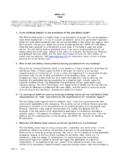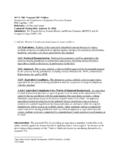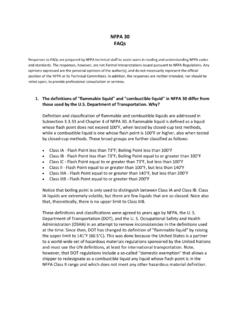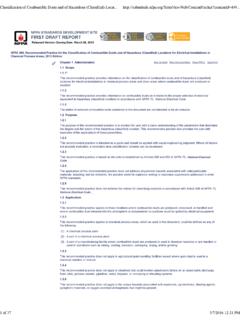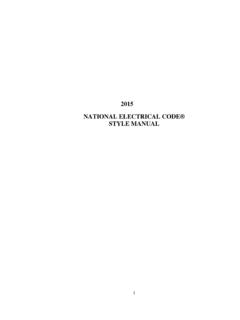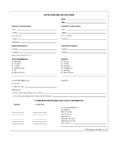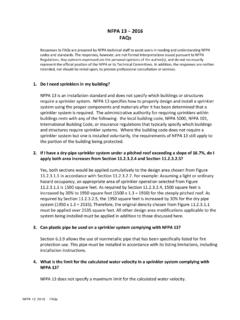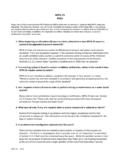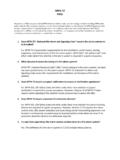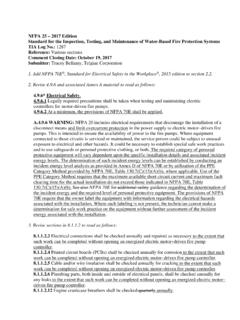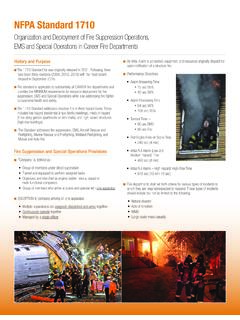Transcription of KEY REQUIREMENTS FOR EMERGENCY SERVICES IN NFPA 1710
1 The minimum REQUIREMENTS for provision of EMERGENCY SERVICES by career fire departments can be found in nfpa 1710, Standard for the Organization and Deployment of Fire Suppression Operations, EMERGENCY Medical Operations, and Special Operations to the Public by Career Fire Departments. nfpa 1710 addresses the structure and operation of organizations providing such SERVICES , which include fire suppression and other assigned EMERGENCY response responsibilities such as EMS and special operations. Occupancy Type: Single-Family Dwelling Deployment: Minimum of 16 members or 17 if aerial device is usedThe initial full alarm assignment to a structure fire in a typical 2000 ft2 (186 m2), two-story, single-family dwelling without a basement and with no exposures must provide for a minimum of 16 members (17 if an aerial device is used).
2 Occupancy Type: Open-Air Strip MallDeployment: Minimum of 27 members or 28 if aerial device is usedThe initial full alarm assignment to a structure fire in a typical open-air strip shopping center ranging from 13,000 ft2 to 196,000 ft2 (1203 m2 to 18,209 m2) in size must provide for a minimum of 27 members (28 if an aerial device is used).Occupancy Type: Garden-Style Apartment Deployment: Minimum of 27 members or 28 if aerial device is usedThe initial full alarm assignment to a structure fire in a typical 1200 ft2 (111 m ) apartment within a three-story, garden-style apartment building must provide for a minimum of 27 members (28 if an aerial device is used).
3 Occupancy Type: High-Rise Deployment: Minimum of 42 members or 43 if building is equipped with fire pumpThe initial full alarm assignment to a fire in a building with the highest floor greater than 75 ft (23 m) above the lowest level of fire department vehicle access must provide for a minimum of 42 members (43 if the building is equipped with a fire pump).KEY REQUIREMENTS FOR EMERGENCY SERVICES IN nfpa 1710 FACT SHEETThe REQUIREMENTS intend to provide effective, efficient, and safe protective SERVICES to help prevent fires, reduce risk to lives and property, deal with incidents that occur, and help prepare for anticipated REQUIREMENTS are listed in nfpa 1710 for fire department service deployment based on the type of occupancy, along with the appropriate response staffing levels for each.
4 The minimum staffing level for each occupancy is listed below. For the full breakdown of staffing REQUIREMENTS by position, refer to the subsections specific to each occupancy in REQUIREMENTS This material contains some basic information about nfpa 1710, Standard for the Organization and Deployment of Fire Suppression Operations, EMERGENCY Medical Operations, and Special Operations to the Public by Career Fire Departments. It identifies some of the REQUIREMENTS in these documents as of the date of publication. This material is not the official position of any nfpa Technical Committee on any referenced topic which is represented solely by the nfpa documents on such topic in their entirety.
5 For free access to the complete and most current version of all nfpa documents, please go to While every effort has been made to achieve a work of high quality, neither the nfpa nor the contributors to this material guarantee the accuracy or completeness of or assume any liability in connection with this information. Neither the nfpa nor the contributors shall be liable for any personal injury, property, or other damages of any nature whatsoever, whether special, indirect, consequential, or compensatory, directly or indirectly resulting from the publication, use of, or reliance upon this material.
6 Neither the nfpa nor the contributors are attempting to render engineering or other professional SERVICES . If such SERVICES are required, the assistance of a professional should be sought. 2020 National Fire Protection Association / June 2020 FACT SHEETADDITIONAL REQUIREMENTSFire departments that respond to fires in occupancies that present hazards greater than those found in must deploy additional resources on the initial alarm as described in though fireground staffing levels have changed, nfpa 1710 continues to require that engine companies be staffed with a minimum of four on-duty members, as stated in In addition.
7 Requires that the fire department identify minimum company staffing levels as necessary to meet the deployment criteria required in to ensure that a sufficient number of members are assigned, on duty, and available to safely and effectively respond with each changes to the 2020 edition of the standard include an update to the definition for career fire department and a clarification of how to determine if the department would fall under either nfpa 1710 or nfpa 1720, Standard for the Organization and Deployment of Fire Suppression Operations, EMERGENCY Medical Operations, and Special Operations to the Public by Volunteer Fire Departments.
8 Several new definitions relating to geographic areas based on population density have been added and the number of responders needed based on the type of incident and tasks to accomplish has been included. New REQUIREMENTS have been added for mobile water supply tankers/tenders and deployment and training of incident safety officers. Also, material on wildland fire suppression has been REQUIREMENTS FOR EMERGENCY SERVICES IN nfpa 1710 CONTINUEDL earn More Visit for free digital access to the standard. Sign up on to: Get one-on-one help with your technical questions at Access exclusive content Search content and connect with your peers to share information and answer questions on nfpa s online community at OBJECTIVESD ocumenting the benchmarks and response objectives that make up nfpa 1710 is crucial to capturing and tracking data that would be helpful in ensuring the necessary allocation of ObjectivesAlarm answer15 sec 95% of the timeor40 sec 99% of the timeAlarm processing64 sec 95% of the timeor106 sec 99% of the timeTurnout - Fire80 secTurnout - EMS60 secFirst-due
9 Engine240 sec (4 min)90% of the timeSecond-due engine360 sec (6 min)90% of the timeInitial full alarm - Low/ medium hazard480 sec (8 min)90% of the timeInitial full alarm - High hazard610 sec (10 min 10 sec)90% of the tim
